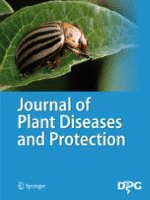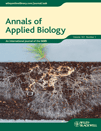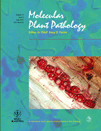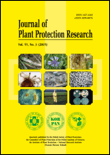
Journal of Plant Diseases and Protection
Scope & Guideline
Elevating Understanding of Plant Diseases
Introduction
Aims and Scopes
- Plant Pathology and Disease Management:
Research related to the identification, characterization, and management of plant diseases caused by fungi, bacteria, viruses, and nematodes, emphasizing integrated approaches to disease control. - Pest Management Strategies:
Studies focusing on the ecology and management of agricultural pests, including the use of biological control agents, botanical pesticides, and synthetic chemicals, to develop sustainable pest management practices. - Molecular and Genetic Studies:
Research utilizing molecular techniques to understand plant-pathogen interactions, pathogen evolution, and genetic resistance in plants, contributing to the development of resistant varieties. - Ecological Impact Assessment:
Investigations into the ecological consequences of pest and disease management practices, including the effects on non-target organisms and the environment. - Innovative Technologies in Agriculture:
Application of novel technologies such as machine learning, imaging techniques, and bioinformatics in the diagnosis and management of plant diseases and pests. - Sustainability and Agroecology:
Research promoting sustainable agricultural practices, including the use of organic amendments, biopesticides, and ecological approaches to enhance plant health and productivity.
Trending and Emerging
- Biological Control and Eco-Friendly Approaches:
A growing trend towards research on biological control agents, including entomopathogenic fungi and bacteria, as well as the use of plant-derived pesticides, is evident as the agricultural community seeks sustainable alternatives to chemical control. - Precision Agriculture and Technology Integration:
There is an increasing focus on the integration of technology in agriculture, including the use of machine learning, remote sensing, and precision application techniques for disease detection and pest management. - Genomics and Molecular Tools:
Emerging research utilizing genomic and molecular tools to enhance understanding of plant-pathogen interactions and develop genetically resistant plant varieties is gaining traction. - Climate Change Impact Studies:
Research exploring the effects of climate change on plant diseases and pest dynamics is becoming more prominent, reflecting the need to address future agricultural challenges. - Interdisciplinary Approaches to Crop Protection:
A trend towards interdisciplinary research that combines insights from plant pathology, entomology, and ecology is emerging, promoting comprehensive strategies for managing plant health.
Declining or Waning
- Traditional Chemical Pesticides:
There is a noticeable decline in studies focusing solely on conventional chemical pesticides, as the research community shifts towards integrated pest management and eco-friendly alternatives. - Local and Regional Case Studies:
Research centered exclusively on localized pest or disease outbreaks is less prevalent, perhaps overshadowed by broader studies and meta-analyses that offer global perspectives. - Basic Agronomy Research:
Studies focusing solely on fundamental agronomic practices without a direct link to disease or pest management are becoming less common, as the emphasis moves towards integrated approaches.
Similar Journals

JOURNAL OF HORTICULTURAL SCIENCE & BIOTECHNOLOGY
Advancing horticultural innovation through cutting-edge research.JOURNAL OF HORTICULTURAL SCIENCE & BIOTECHNOLOGY, published by Taylor & Francis Ltd, stands as a prestigious platform in the realms of both horticulture and biotechnology. With an ISSN of 1462-0316 and an E-ISSN of 2380-4084, this journal showcases cutting-edge research that advances our understanding of plant science and genetic innovation. Operating under the publication umbrella from 1996 to 2024, the journal has achieved notable rankings, placing in the Q3 quartile for Genetics and Q2 for Horticulture in 2023. With a Scopus ranking of #25/115 in Agricultural and Biological Sciences (Horticulture) and a respectable 78th percentile, it is highly regarded among researchers and professionals alike. While currently not designated as Open Access, the journal remains crucial for academics keen on disseminating groundbreaking findings and techniques that foster advancements in agricultural productivity and sustainability. As an essential resource for researchers, professionals, and students, JOURNAL OF HORTICULTURAL SCIENCE & BIOTECHNOLOGY not only facilitates knowledge sharing within its community but also serves as a vital reference point for future innovations in the field.

ANNALS OF APPLIED BIOLOGY
Exploring the intersection of biology and agronomy.Annals of Applied Biology, published by Wiley, stands as a pivotal resource in the fields of Agronomy and Crop Science, boasting an impressive impact factor that reflects its significance and influence in the academic community. With a storied history dating back to 1914, this journal serves as a comprehensive platform for innovative research and applied studies in agricultural biology, specifically aimed at improving crop production and sustainable practices. Currently categorized in the Q1 quartile for Agronomy and Crop Science in 2023, it ranks an admirable 82 out of 406 in the Scopus database, placing it within the top 79th percentile of its category. Researchers, professionals, and students worldwide rely on the Annals of Applied Biology for cutting-edge insights and advancements in applied biological research, making it a vital component of the scientific discourse aimed at addressing pressing agricultural challenges. Please note that this journal does not offer open access options, thus ensuring a rigorous peer review process and the integrity of published work.

Revista de la Facultad de Agronomia de la Universidad del Zulia
Exploring the Future of Food and Agriculture in Latin AmericaWelcome to the Revista de la Facultad de Agronomia de la Universidad del Zulia, a key publication in the fields of Agronomy, Animal Science, Food Science, and Plant Science. Published by the Facultad de Agronomía, Universidad del Zulia, this journal aims to foster academic dialogue and disseminate impactful research that advances knowledge and practice within these disciplines. Operating under the ISSN 0378-7818 and E-ISSN 2477-9407, this journal offers a platform for both emerging and established scholars to share their discoveries and innovations. Despite its challenges, as reflected in its Q4 ranking across multiple categories in 2023, it remains a vital resource for the Venezuelan scientific community and beyond. Readers will benefit from a diverse array of studies and discussions that address contemporary issues in agriculture and related fields, helping inform best practices and policy. Engage with cutting-edge research from Venezuela and contribute to the development of agronomic sciences in the region.

JOURNAL OF PLANT PATHOLOGY
Transforming Knowledge into Solutions for AgricultureJOURNAL OF PLANT PATHOLOGY, published by SPRINGER, is a premier academic journal dedicated to advancing the understanding of phytopathology and related fields. With a strong international presence and an impact factor that reflects its influence in the scientific community, this journal offers essential insights to researchers, professionals, and students engaged in plant health. Since its inception in 1997, it has consistently provided a platform for innovative research, contributing to the Q2 rank in Plant Science as per the 2023 category quartiles. The journal covers a broad spectrum of topics related to plant diseases, their management, and the ecological impacts they pose, ensuring relevance to contemporary challenges in agriculture and sustainability. While the journal does not currently offer Open Access options, it remains a crucial resource for those looking to deepen their knowledge and bolster their research endeavors in the vital area of plant pathology.

MOLECULAR PLANT PATHOLOGY
Elevating the science of plant protection.MOLECULAR PLANT PATHOLOGY, published by Wiley, is a leading academic journal in the fields of Agronomy, Molecular Biology, Plant Science, and Soil Science, with a strong reputation underscored by its impressive Q1 rankings across multiple categories and a Scopus rank placing it in the top echelons of its fields. Since embracing Open Access in 2019, this journal has significantly broadened its reach, enhancing visibility and accessibility for researchers, professionals, and students alike. With a commitment to publishing high-quality, innovative research, MOLECULAR PLANT PATHOLOGY serves as a critical platform for advancing our understanding of plant diseases and pathogenesis, contributing to the development of sustainable agricultural practices. As a vital resource for scholarly communication, it fosters collaboration among scientists and supports the sharing of vital knowledge that addresses issues of global food security and environmental health.

PLANT PROTECTION SCIENCE
Fostering innovation in crop science for global impact.PLANT PROTECTION SCIENCE, published by the Czech Academy Agricultural Sciences, is an esteemed journal dedicated to advancing the field of agronomy, crop science, and soil science. With a strong open access policy since 2007, this journal has made significant contributions to the dissemination of research relevant to plant protection, sustainable agriculture, and environmental preservation. Operating from Prague, Czech Republic, it has successfully positioned itself within the Q2 category in Agronomy and Crop Science and Q3 in Soil Science as of 2023, highlighting its relevance and influence in these vital areas of agricultural research. According to Scopus, its rankings reflect a respectable standing, with percentile ranks of 58th in Agronomy and Crop Science and 53rd in Soil Science. Researchers, professionals, and students are encouraged to explore its rich repository of peer-reviewed articles, which aim to address critical challenges in plant health and production, thereby fostering innovation in agricultural practices.

AUSTRALASIAN PLANT PATHOLOGY
Unraveling the complexities of plant diseases across the region.Australasian Plant Pathology, published by Springer, is a leading journal in the field of plant science that focuses on the study of plant diseases and their management across the Australasian region. With an established history since 1978, the journal aims to provide a platform for high-quality research that enhances our understanding of plant pathology, prevention strategies, and sustainable management practices. With an impact factor that reflects its significance in the scientific community and its Q3 quartile ranking in 2023 among plant science journals, it serves as a vital resource for researchers, professionals, and students alike. Although it does not have Open Access options, the journal ensures that its content, which spans a wide spectrum of plant pathology topics, remains accessible to a diverse audience globally. With a commitment to advancing knowledge in this crucial area of study, Australasian Plant Pathology continues to play an essential role in addressing the challenges posed by plant diseases in a changing environment.

JOURNAL OF PLANT PROTECTION RESEARCH
Championing global access to vital agricultural discoveries.JOURNAL OF PLANT PROTECTION RESEARCH is a pivotal publication in the realm of agricultural sciences, dedicated to advancing our understanding of plant protection and pest management. Published by the INST OCHRONY ROSLIN, PANSTWOWY INST BADAWCZY in Poland, this journal has been an open-access venue since 2008, ensuring that research findings are readily accessible to a global audience. With an ISSN of 1427-4345 and E-ISSN of 1899-007X, it serves as a crucial platform for scholars and practitioners in the fields of Agronomy, Plant Science, and Soil Science. In the latest categorizations, it has achieved a Q3 ranking in these disciplines, reflecting its impact and significance within the scientific community. As the journal converges its scope from 2008 to 2024, it continues to address pressing issues in plant health and sustainability. Its strategic placement within the Scopus ranks offers valuable insights into agricultural and biological sciences, making it an essential read for those seeking to enhance their expertise in plant protection strategies.

PHYTOPARASITICA
Advancing the Frontiers of Plant and Insect Science.PHYTOPARASITICA, published by SPRINGER in the Netherlands, is a distinguished journal dedicated to the fields of Insect Science and Plant Science. With an impressive convergence of research from 1973 to 2024, the journal holds a notable position in academic circles, ranking in Q2 for both categories as of 2023, according to Scopus metrics. This places PHYTOPARASITICA within the top 67th percentile for Insect Science and the 59th percentile for Plant Science, reflecting its significant impact on research and advancements in these crucial fields. The journal is committed to disseminating high-quality, peer-reviewed research that addresses the interplay between plants and their parasitic organisms, contributing to the broader understanding of agricultural sustainability and ecological balance. Researchers, professionals, and students will find this journal an essential resource for cutting-edge insights and developments within its domain.

Bioagro
Advancing sustainable solutions in agriculture and biology.Bioagro is an esteemed academic journal dedicated to advancing research in the field of Agricultural and Biological Sciences. Published by the University Centroccidental Lisandro Alvarado in Venezuela, this journal has made significant strides since its inception in 2008, with a focus on delivering high-quality research publications that address contemporary challenges in agriculture and biology. Recognized for its contributions, it holds a Q3 ranking in the Agricultural and Biological Sciences (miscellaneous) category as of 2023, and it ranks #125 out of 221 in its field, placing it in the 43rd percentile. Although it operates on an Open Access model, Bioagro strives to provide broad access to innovative research, thereby fostering collaboration and knowledge dissemination among researchers, professionals, and students. With a commitment to include a wide range of topics, the journal aims to be a pivotal platform for exploration and dialogue in agricultural sciences, ensuring that key findings reach both scientific and practitioner audiences. Located in Barquisimeto-Cabudare, Lara, Venezuela, Bioagro invites submissions that contribute to the global discourse on sustainable practices and innovations in agriculture.